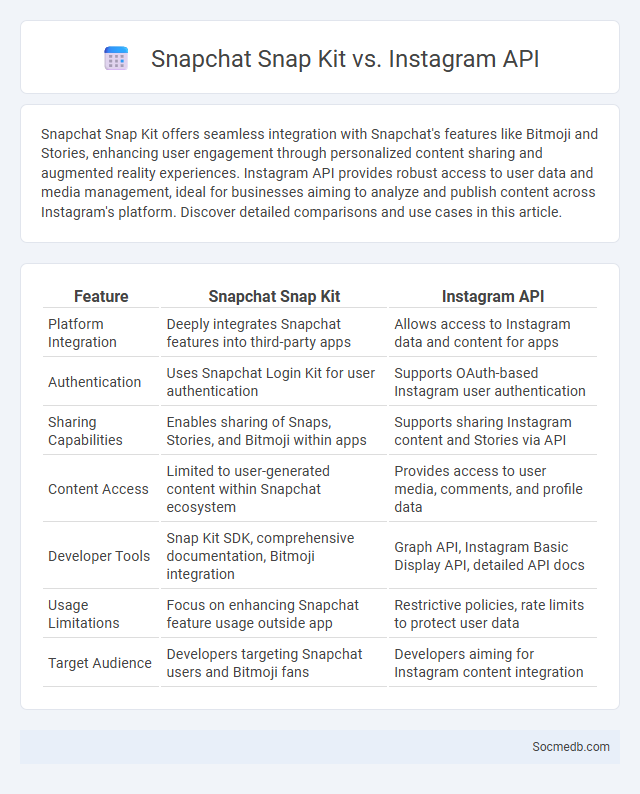
Photo illustration: Snapchat Snap Kit vs Instagram API
Snapchat Snap Kit offers seamless integration with Snapchat's features like Bitmoji and Stories, enhancing user engagement through personalized content sharing and augmented reality experiences. Instagram API provides robust access to user data and media management, ideal for businesses aiming to analyze and publish content across Instagram's platform. Discover detailed comparisons and use cases in this article.
Table of Comparison
| Feature | Snapchat Snap Kit | Instagram API |
|---|---|---|
| Platform Integration | Deeply integrates Snapchat features into third-party apps | Allows access to Instagram data and content for apps |
| Authentication | Uses Snapchat Login Kit for user authentication | Supports OAuth-based Instagram user authentication |
| Sharing Capabilities | Enables sharing of Snaps, Stories, and Bitmoji within apps | Supports sharing Instagram content and Stories via API |
| Content Access | Limited to user-generated content within Snapchat ecosystem | Provides access to user media, comments, and profile data |
| Developer Tools | Snap Kit SDK, comprehensive documentation, Bitmoji integration | Graph API, Instagram Basic Display API, detailed API docs |
| Usage Limitations | Focus on enhancing Snapchat feature usage outside app | Restrictive policies, rate limits to protect user data |
| Target Audience | Developers targeting Snapchat users and Bitmoji fans | Developers aiming for Instagram content integration |
Overview of Snapchat Snap Kit
Snap Kit is a powerful developer platform created by Snapchat that enables third-party apps to integrate Snapchat features such as Login Kit, which allows users to sign in with their Snapchat credentials seamlessly. Creative Kit allows sharing of customized content and stickers directly to Snapchat Stories, while Bitmoji Kit enables apps to link users' Bitmoji avatars for personalized experiences. Other components include Story Kit for accessing public Stories and Ad Kit for monetizing apps through Snapchat ads, enhancing user engagement and expanding Snapchat's social ecosystem.
Understanding Instagram API
The Instagram API enables developers to access user profiles, media, comments, and insights, facilitating seamless integration with third-party applications. Key endpoints include User, Media, Hashtag, and Insights, supporting functions such as content publishing, data analytics, and audience engagement tracking. Proper use of Instagram's Graph API requires compliance with their platform policies and authentication via OAuth to ensure secure data access.
Key Features of Snap Kit
Snap Kit integrates Snapchat's core functionalities into third-party apps, enabling features like Bitmoji avatar integration, login with Snapchat credentials, and seamless content sharing. It offers Creative Kit for sharing customized stickers and filters, while Login Kit enhances user authentication securely. These tools boost user engagement and personalization by leveraging Snapchat's extensive social graph and multimedia capabilities.
Core Differences Between Snap Kit and Instagram API
Snap Kit offers seamless integration with Snapchat's unique features such as Bitmoji and Stories, enabling developers to leverage Snapchat's augmented reality tools and creative channels. Instagram API focuses primarily on content management, providing robust access for publishing, user insights, and media interaction to help you manage your Instagram presence effectively. The core difference lies in Snap Kit's creative, interactive capabilities versus Instagram API's emphasis on content analytics and publishing functionalities.
Integration Capabilities for Developers
Social media platforms offer robust integration capabilities through APIs, enabling developers to seamlessly embed features like user authentication, content sharing, and data analytics into their applications. These APIs support various programming languages and frameworks, providing flexible access to real-time social data and user interactions. Enhanced integration tools streamline the development process, facilitating the creation of customized social experiences that boost user engagement and retention.
Security and Privacy Considerations
Social media platforms prioritize security measures such as end-to-end encryption and multi-factor authentication to protect user data from unauthorized access and breaches. Privacy settings allow users to control the visibility of their personal information and manage who can interact with their content. Awareness of phishing scams, malware risks, and data harvesting practices is essential for maintaining a secure social media experience.
User Engagement and Social Sharing
User engagement on social media is driven by interactive content such as polls, live videos, and personalized posts that encourage active participation and foster community building. Social sharing amplifies brand reach by enabling users to distribute content across multiple platforms, leveraging network effects to increase visibility and credibility. Metrics like share rate, comments, and likes are critical indicators for optimizing content strategies and enhancing overall engagement performance.
Platform Limitations and Restrictions
Social media platforms impose various limitations such as character counts, content type restrictions, and user engagement controls to maintain community standards and prevent abuse. These restrictions include bans on hate speech, misinformation, and explicit content, enforced through automated algorithms and human moderators. Platform-specific policies also limit data access for third-party developers, affecting integration and analytics capabilities.
Monetization Opportunities for Businesses
Social media platforms offer diverse monetization opportunities for businesses, including targeted advertising, influencer partnerships, and direct sales through shoppable posts. Leveraging data analytics helps optimize campaign performance and enhance customer engagement, driving higher conversion rates. Your business can increase revenue streams by integrating these social media strategies into a comprehensive digital marketing plan.
Choosing the Right API for Your App
Selecting the right social media API for your app involves evaluating key factors like data accessibility, rate limits, and supported features such as user authentication, posting, and analytics. Major platforms like Facebook Graph API, Twitter API v2, and Instagram Basic Display API offer diverse capabilities tailored to different app requirements and user engagement goals. Prioritize APIs with robust documentation, strong developer support, and compliance with privacy policies to ensure seamless integration and sustainable growth.
 socmedb.com
socmedb.com